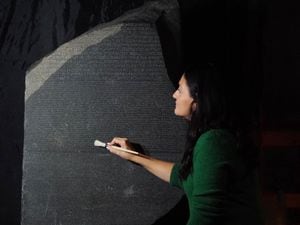Rosetta Stone moved for first time in 18 years
Hieroglyphs: Unlocking Ancient Egypt will go on display from October 13.

The Rosetta Stone has temporarily moved to a special exhibition in the British Museum to celebrate 200 years since hieroglyphs were decoded.
It is the first time the ancient object has been relocated since it was installed in the Egyptian Sculpture Gallery 18 years ago.
In 1799, the inscribed slab was stumbled upon by a group of soldiers and later it went on to became the key that unlocked the mysterious hieroglyphic script of ancient Egypt.
The stone will be at the heart of the British Museum’s Hieroglyphs: Unlocking Ancient Egypt exhibition which will be on display from October 13 until February 19.
Exhibition curator Ilona Regulski told the PA news agency: “We are telling the story of decipherment of Egyptian hieroglyphs which happened 200 years ago, so that’s what we’re celebrating.
“The Rosetta Stone is crucial to the story of decipherment because it provided the key to decipher hieroglyphs.
“We wouldn’t be able really to tell the story of the decipherment of hieroglyphs without the Rosetta Stone, so we decided that it would have a good place in the exhibition.
“Also, it provides us with an opportunity to contextualise the story a bit better and to tell more complete stories about the role of the stone in the decipherment, but also how it came to the British Museum.”
Ms Regulski said the Rosetta Stone was in Paris’ Louvre Museum “for a very brief period” in 1972 and was also moved during the Second World War for its protection, but has not been moved in 18 years.

Speaking about how long the exhibition took to curate, she said: “I think about three years. I think I started doing research in 2019.
“You build the story in your head as a curator and then at a certain point, I think a bit more than a year out, we kind of got the core team together.
“Now it’s quite a big team because we’re building the exhibition. I am very excited.”
Ms Regulski, who is also the curator of written culture at the British Museum, said they are replacing the Rosetta Stone with a temporary display.
“We are, of course, using this opportunity of the empty showcase to make a new display and it is almost ready,” she said.
“It’s an opportunity to rethink that whole display and that area, which is really a crossroads between different cultures of the ancient world.
“We’re using this as a kind of pilot to look at how we can address the story of the different cultures of the ancient world being interconnected.”
The immersive display, which will include digital media and audio, will bring together more than 240 objects charting the race to decipherment.
A star object in the display will feature “the enchanted basin” – a large black granite sarcophagus covered with hieroglyphs from about 600 BCE.

The hieroglyphs were believed to have magical powers and bathing in the basin could offer relief from the torments of love.
Similarly, the 3,000-year-old illustrated Book of the Dead of Queen Nedjmet will feature alongside a set of canopic vessels that preserved the organs of the deceased.
It will be the first time a set of jars have been reunited since the 1700s, the museum said.
The mummy bandage of Aberuait from the Musee du Louvre in Paris, which has never been displayed in the UK, will also be on show.
Speaking about her aspirations for the exhibition, Ms Regulski added: “I hope visitors will, of course, learn about ancient Egypt. It’s always a wonderful opportunity to show new research about one of the most amazing ancient civilisations.
“I hope they understand that ancient Egypt was a distant culture but also is relevant to understand human practices today, we have a lot in common with the ancient people.
“I tried to show that by deciphering hieroglyphs, we really get an insight into ancient Egypt that wasn’t possible before.
“We understand much better now how common people lived, how they enjoyed writing, because most people couldn’t read and write of course, so they would have enjoyed written culture by listening to it, by performances and citations.
“I hope to really bring the message across that behind hieroglyphs there is a spoken language, it was a means to communicate with each other.”





